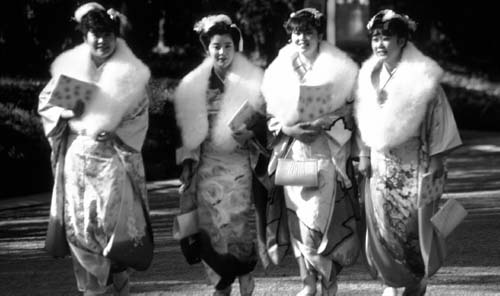ShintoCustoms and Rituals |
Are there other distinctive Shinto rites of passage or initiation? |
Several types of ceremony and celebration are associated with various stages in life. Tradition recommends that parents (formerly the grandmother, since mothers remained impure for a time after childbirth) bring thirty-two-day-old boys or thirty-three-day-old girls to the shrine for a blessing. This “first shrine visit” (hatsu-miya-mairi) functioned as the infant’s initiation into the Shinto shrine community. Older children also have their days. Each November 15, a festival called Shichi-go-san (“Seven-five-three”) marks a rite of passage for both boys and girls. Three- and seven-year-old girls and five-year-old boys don their fanciest dress-up outfits for a shrine visit to pray for a safe and happy future. Putting on celebratory clothes is a major ingredient in rites of initiation. Young people reach the age of adulthood at twenty. On “Coming of Age Day” (seijin-no-hi)— January 15 each year—young adults, especially women, visit shrines in formal attire for a blessing. Other coming-of-age observances identify manhood with age seventeen and womanhood with nineteen, acknowledging the difficulty of life’s changes with the bestowal of protective talismans. Many older Japanese still observe rites of passage that acknowledge the challenges of aging. They may visit shrines when they reach the ages of 61, 70, 77, 88, and 99, to ask for protection and blessings.

Young Japanese women walking along the main path of one of Tokyo’s major Shinto shrines after celebrating the annual Coming of Age Day (seijin no hi) for which they are decked out in their fanciest traditional dress.
